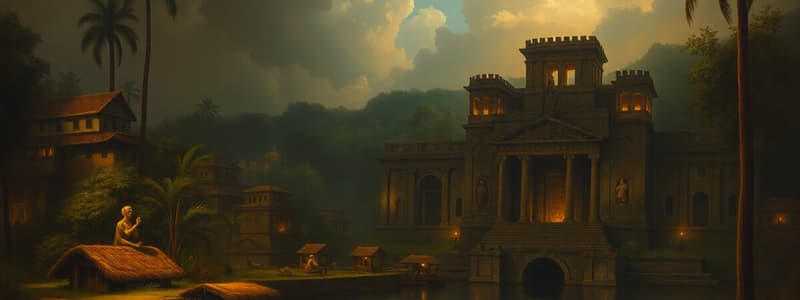Podcast
Questions and Answers
Which farming method allowed the Maya to adapt to their tropical environment by preventing crops from flooding?
Which farming method allowed the Maya to adapt to their tropical environment by preventing crops from flooding?
- Slash-and-burn agriculture
- Dryland farming
- Raised field farming (correct)
- Terraced farming techniques
What distinguished the governance of Maya city-states from empires typically seen in ancient civilizations?
What distinguished the governance of Maya city-states from empires typically seen in ancient civilizations?
- Each city-state had a shared ruler
- There was no centralized government structure (correct)
- Governance was based solely on military strength
- City-states were united under a single monarch
In the social hierarchy of the Maya, who primarily held the roles of military leadership and public work management?
In the social hierarchy of the Maya, who primarily held the roles of military leadership and public work management?
- Scribes
- Farmers
- Nobles (correct)
- Merchants
Which of the following items was NOT typically traded by Maya city-states?
Which of the following items was NOT typically traded by Maya city-states?
During the Classic Period, which two city-states were considered the most powerful among the Maya?
During the Classic Period, which two city-states were considered the most powerful among the Maya?
What primary purpose did the pyramidal platforms serve in Mayan cities?
What primary purpose did the pyramidal platforms serve in Mayan cities?
Which descriptions accurately define the religious practices of the Maya?
Which descriptions accurately define the religious practices of the Maya?
What element of the Maya civilization contributed significantly to their ability to conduct ceremonies accurately?
What element of the Maya civilization contributed significantly to their ability to conduct ceremonies accurately?
What were some suggested reasons for the decline of the Maya civilization around 900 A.D.?
What were some suggested reasons for the decline of the Maya civilization around 900 A.D.?
What significant feature of the Mayan writing system distinguishes it from many others?
What significant feature of the Mayan writing system distinguishes it from many others?
Flashcards are hidden until you start studying
Study Notes
Maya Civilization
- The Maya were the first to build large cities in present-day Guatemala around 300 B.C.
- The Maya Golden Age, or the Classic Period, began around 250 A.D., with city-states flourishing from the Yucatán Peninsula to Central America.
- Before developing large population centers, the Maya lived dispersed across the land.
- The Maya innovated farming techniques to thrive in tropical environments.
- To cultivate land, the Maya cleared forests.
- They built raised fields along riverbanks to elevate crops above annual floodwaters and ensure sufficient food production for rapidly growing cities.
- Maya cities, though thriving, never formed a single empire.
- Numerous city-states existed, with Tikal and Calakmul being the most powerful.
- Inter-city state conflicts and warfare were prevalent.
- Regular trade between city-states created substantial wealth.
- Traded goods included daily necessities like honey, salt, and cotton, and luxury items like feathers, precious stones, and jaguar hides.
- The Maya featured a distinct social hierarchy.
- Each city was governed by a ruler, typically male.
- Women occasionally governed independently or as representatives of their young sons.
- The nobility managed various functions, including military leadership, public works, tax collection, and law enforcement.
- Scribes, painters, and sculptors held high esteem.
- Merchants formed a middle class, with the wealthiest becoming part of the nobility.
- Farmers constituted the majority of Maya society, cultivating maize, beans, squash, fruit trees, cotton, and flowers.
- Slavery existed in certain cities, typically involving prisoners of war.
- The Maya civilization made significant advancements in learning and the arts.
- They developed a complex polytheistic religion.
- Mayan cities are renowned for their towering stone temples and palaces.
- Temples often rested on pyramid-shaped platforms and served as places for priests to perform rituals and sacrifices.
- Some temples also functioned as burial sites for rulers, nobles, and priests.
- The Maya devised a hieroglyphic writing system that remained undeciphered by scholars until recent decades.
- Mayan priests became experts in mathematics and astronomy to precisely measure time for ceremonies.
- They created a solar calendar with 365 days and a number system incorporating the concept of zero.
- Around 900 A.D., Maya city building ceased, marking the beginning of their civilization's decline.
- The reasons for this decline are debated, with potential explanations including overpopulation, disease, drought, or peasant revolts against the priesthood and nobility.
- By the time the Spanish arrived in the 1500s, most Maya inhabited farming villages.
Studying That Suits You
Use AI to generate personalized quizzes and flashcards to suit your learning preferences.




